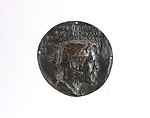John Singer Sargent
Augustus Saint-Gaudens American
Not on view
Saint-Gaudens’s and Sargent’s remarkable careers developed along parallel tracks. Both prodigiously gifted, they met in Paris in 1877 or 1878 while Saint-Gaudens was at work on his Farragut Monument and Sargent (1856-1925) was studying in the independent atelier of Carolus-Duran and enjoying early success exhibiting his society portraits and genre scenes in the Paris Salons. Sculptor and painter traveled in the same international cosmopolitan circles, sharing not only friends but also patrons. Saint-Gaudens advised Sargent on sculptural elements for his great mural cycle for the Boston Public Library (1890-1916), and he moved to London in 1886 Sargent reciprocated by introducing Saint-Gaudens to his British colleagues and prospective clients.
This medal, Saint-Gaudens’s first, is the smallest of the friendship portraits completed during his Paris tenure. The likeness of his friend is both matter-of-fact and piercing. The inscription on the grainy-textured field, BRVTTO RITRATTO, defies exact interpretation. Literally it means "crude portrait," which might imply that the sculptor was apologizing for the hasty execution, but "brutto" may also refer to Sargent’s forceful and vigorous person, captured on an ironic miniature scale, or it may be an allusion to ancient Roman coins, with their irregular surfaces and profile portrait busts.
The medal was given to the Metropolitan by the wife of Edward Robinson, director of the Museum from 1910 to 1931. The Robinsons were close friends of Sargent’s, and they helped the Metropolitan acquire a number of his oils and works on paper, often directly from him.
Due to rights restrictions, this image cannot be enlarged, viewed at full screen, or downloaded.

